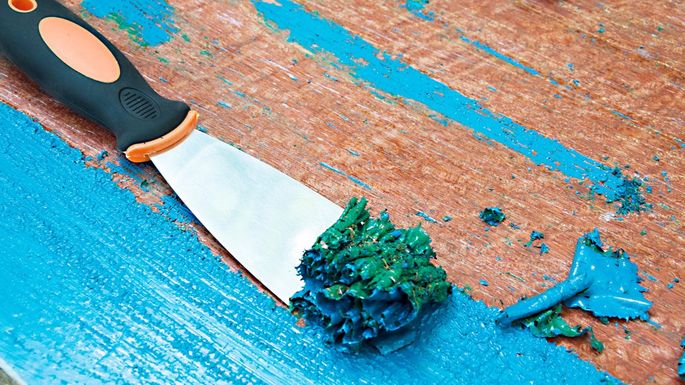
Removing paint from a wood surface, more commonly referred to as paint stripping, is the process of breaking the paint bond and exposing the wood underneath. Stripping paint is necessary when there are many layers of paint on the surface, dry paint has drip marks or simply to expose and refinish natural wood. Paint is stripped from wood moldings, furniture, floors or wood-based walls such as paneling. There are a few do-it-yourself methods to choose from, pick the easiest method based on your skill level and capabilities.
For Paint Stripping You Will Need
- safety glasses
- heat-resistant gloves
- hot air gun
- metal paint scraper
- chemical paint stripper
- tarp
- paintbrush
- mild detergent
- belt sander
- medium-grit sandpaper
- fine-grit sandpaper
- extra fine-grit sandpaper
- Wear safety glasses and heat-resistant gloves. Keep a fire extinguisher and phone nearby in case of accidental fire. Do not use heat guns near natural gas lines and electrical wires.
- Hold a hot air gun near the wood surface at a 45-degree angle. Do not touch the end of the heat gun to the wall because it is a fire hazard.
- Keep the heat gun in constant motion over a small, manageable area. Move the heat gun back and forth or up and down until the heat begins to bubble the existing paint.
- Use a metal paint scraper to scrape off bubbled paint.
- Move the heat gun to the next area and repeat until all paint has been removed from the wood surface.
Chemical Paint Strippers for Paint Stripping
Chemical paint strippers are messy, but very effective.
Wear chemical-resistant gloves, safety goggles and work in a well-ventilated area. If the area is not well ventilated, set up large fans or wear a chemical approved respirator.
- Lay down tarps or thick layers of newspaper to catch drips and accidental spills.
- Apply a thick layer of chemical stripper to the wood surface with a paintbrush.
- Allow the chemical paint stripper to sit on the surface for the length of time based on the manufacturer’s recommendations.
- Scrape off old paint with a metal paint scraper.
- Wash the surface with a mild detergent to remove chemical residue from the paint stripper.
- Allow the wood to dry thoroughly before refinishing.
Paste or Gel Paint Strippers
Paste and gel paint strippers depend on the same chemical reaction to break old paint bonds from surfaces. Paste strippers work slower than chemical paint strippers, but are more appropriate for areas that are difficult to reach such as carvings or corners.
- Apply a thick layer of paste or gel stripper with a putty, pressing it into carved areas.
- Allow the paste to react, which can take up to 24 hours depending on the brand.
- Scrape off old paint with a metal paint scraper.
- Wash the surface to remove excess chemicals.
Sanding Off Old Paint
Sanding paint works best for small or large flat areas without details, carvings or depressions.
- Load a belt sander with medium-grit sandpaper and sand the surface removing top layers of paint. This is also done by hand sanding.
- Change to fine-grit sandpaper and sand the surface again.
- Finally sand a third time with extra fine-grit sandpaper.
You can find success with any of these methods. Chemical stripping is the easiest, but also the messiest. Sanding will also remove a layer of the wood surface itself. If you are not experienced with sanding, you can cause surface depressions and indentations.
Thank you for reading this article! If you have any further questions about this topic please contact us.
